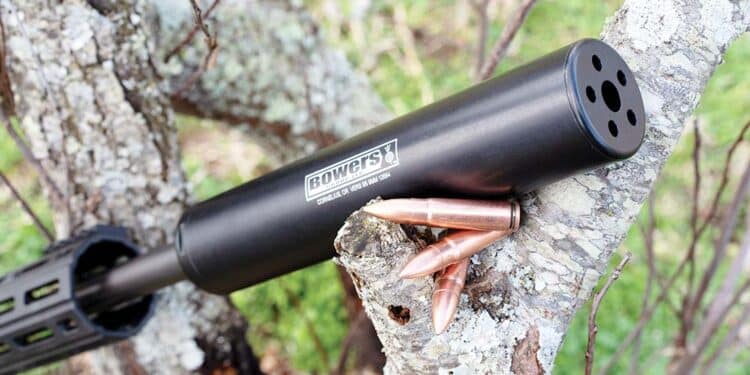Story & Photography by Oleg Volk
Wolf Performance Arms has a history of finding or commissioning high-performing rifle uppers, like the Taiwanese T91 covered by SAR in 2017 (Volk, O., “Wolf Arms A1 Piston Upper,” Vol. 21, No. 5). Last year, they introduced an AR upper with 16-inch and 10.5-inch barrels chambered in 9x39mm Russian. The cartridge has been around since the 1980s, used in numerous sound-suppressed guns, mainly in the VSS Vintorez short-range sniper rifle and AS Val automatic rifle. The development of the ammo goes back decades, having begun as an alternative to subsonic 7.62x39mm, which was determined to be less effective than required. 9x39mm took the obvious expedient of increasing bullet mass and keeping penetration high with a subcaliber steel penetrator. Firearms in this caliber are in use by several former USSR republics and a few of Russia’s Middle Eastern allies, but the propagation is limited to bodyguards and Special Forces.
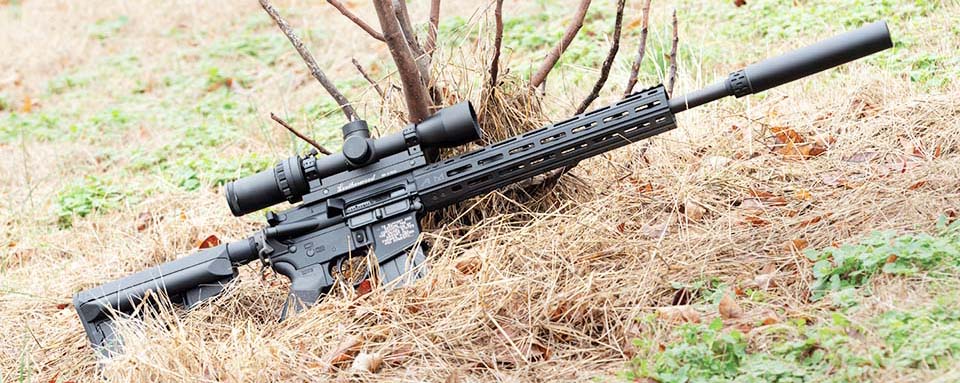
With none of the guns for which 9x39mm was intended being importable, and most of the ammunition being armor-piercing by design and composition, that cartridge was more legendary than known in the West. The main reason for VSS was to engage targets without being detected, and the low velocity of the ammunition was compensated by the hardened steel penetrator designed to defeat body armor and lightly protected vehicles. With neither guns nor ammunition available in the U.S. until recently, most of us could judge the utility of the cartridge only from video games. (Small Arms Review and Small Arms Defense Journal have done extensive testing and presentations on 9x39mm since the mid-2000s; search our websites.)
The 9x39mm Wolf Performance Arms upper is a very well-made conventional design with a long M-LOK forend and medium-weight barrel profile. It has the usual forward assist and ejection port cover, along with the less usual Picatinny rail segment for mounting an iron sight or a laser at the top front of the forend. The muzzle is threaded 5/8×24, a pattern more common in .308 than in 9mm suppressors. Fortunately, a 5/8×24 configuration was available for my Gemtech Multimount, a 9mm pistol and carbine suppressor that is plenty strong for the low-pressure, exclusively subsonic 9x39mm cartridge.
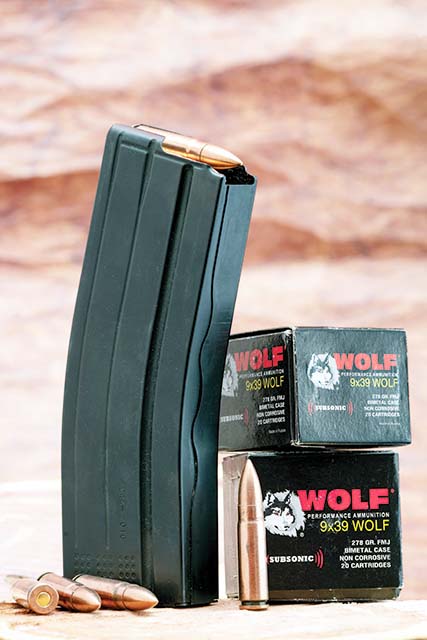
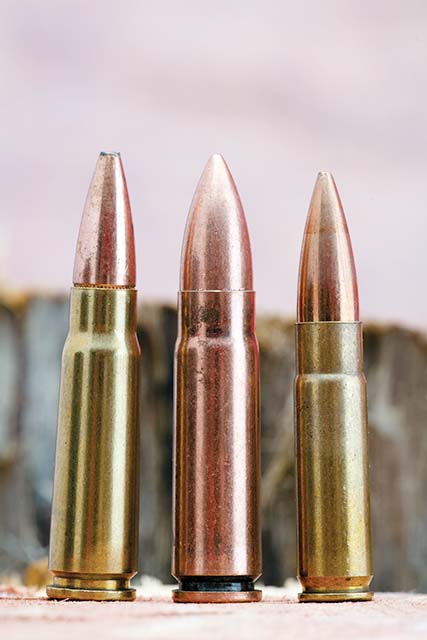
Since none of the specialty rounds are eligible for import, Wolf developed a 278-grain lead core cullet with a copper-washed steel jacket, loaded into a copper-washed steel case. It is available at about 70 cents per round. While this solution reduced armor penetration, it improved the BC (ballistic coefficient) of the bullet slightly compared to the 250- to 260-grain Russian specialty designs. Compared to the military guns using roughly 8-inch barrels and very primitive, if voluminous, sound suppressors, the 16-inch AR with a modern suppressor should perform pretty well. The original military SP-6 armor-piercing ammunition velocity from VSS is in the 925 fps range, and the slightly heavier SP-5 ball ammunition is around 900 fps. The full-length AR barrel yielded an average of 1,045 fps using an even heavier bullet, with a standard deviation of 25.8 fps and extreme spread around 70 fps. Because of that spread in velocity, most groups showed vertical dispersion more than horizontal. Overall, unsuppressed accuracy was consistently better than expected at around 2MOA. The initial testing was done at 60 yards, and then confirmed at 110 yards against a 3-inch target: the 100% hit ratio on it was guaranteed with a 1-6x scope.
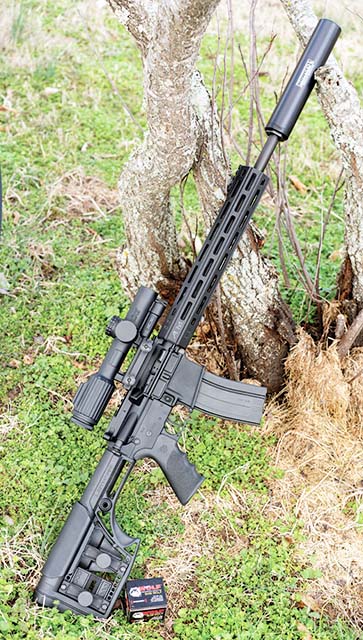
The rifle cycled fine, both suppressed and unsuppressed. I had one dud primer in 60—that cartridge wouldn’t fire even on a re-strike. Ejection was very consistent, with all empties found about 3 feet from the rifle. Even suppressed, the rifle had no gas blowback at all, making it very comfortable to shoot. Felt recoil was on par with .22 rimfire, and the noise level resembled unsuppressed subsonic .22LR from a long barrel and was mainly caused by the ejection port pop.
Magazine Selection
Magazine selection for 9x39mm is a difficult task. None of the magazines intended for other calibers works well; at best 3 to 5 rounds can be fed at a time. D&H Industries recently introduced a dedicated 10-round 9x39mm magazine for the AR platform, with pre-production samples having gone out to testers in the first half of February 2020. They plan to bring out 20-round magazines later in the year. Fortunately, I had a sample of the UNIMAG, one of several inventions from the genius of mechanical engineer Jing Zheng. Produced by Ross Defense Systems, this multi-caliber magazine with an articulated follower supports every cartridge available in AR-15, including 9x39mm. I was able to load and cycle the full 25 rounds, though Steve Dittner of Wolf Performance Arms cautioned me that the springs may be insufficient for pushing up that much weight under field conditions. Twenty rounds weigh about the same as a full mag of subsonic .300 Blackout ammunition and can be expected to feed under all circumstances. Ross Defense Systems is currently liquidating their entire stock of these magazines, so it’s a good time to buy them at a good price.
Compared to .300 Blackout, 9x39mm is more specialized, appearing only in the subsonic configuration. Comparing 220-grain .300 Blackout to 278-grain 9x39mm with both fired from 16-inch rifles, the trajectories are almost identical for drop and windage out to 500 yards. With a 100-yard zero, mid-trajectory, height is only 3 inches at 60 yards, with the same drop at 125 yards. Point blank range on a torso-sized target is about 150 yards, with trajectory compensation required beyond that. Russian military optics have BDC reticles calibrated to their barrel length and SP-5 armor-piercing ammunition, while we get to make our own dope charts. At this time, .300 Blackout has the advantage of having a vastly greater variety of ammunition types available, as well as the compatibility with 5.56 magazines and with .30-caliber sound suppressors. 9x39mm has the advantage of being a slightly heavier bullet—278 grain versus 220 grain—for improved terminal performance with ball. Ammunition with expanding bullets is in development by several companies, but none are on the market yet.
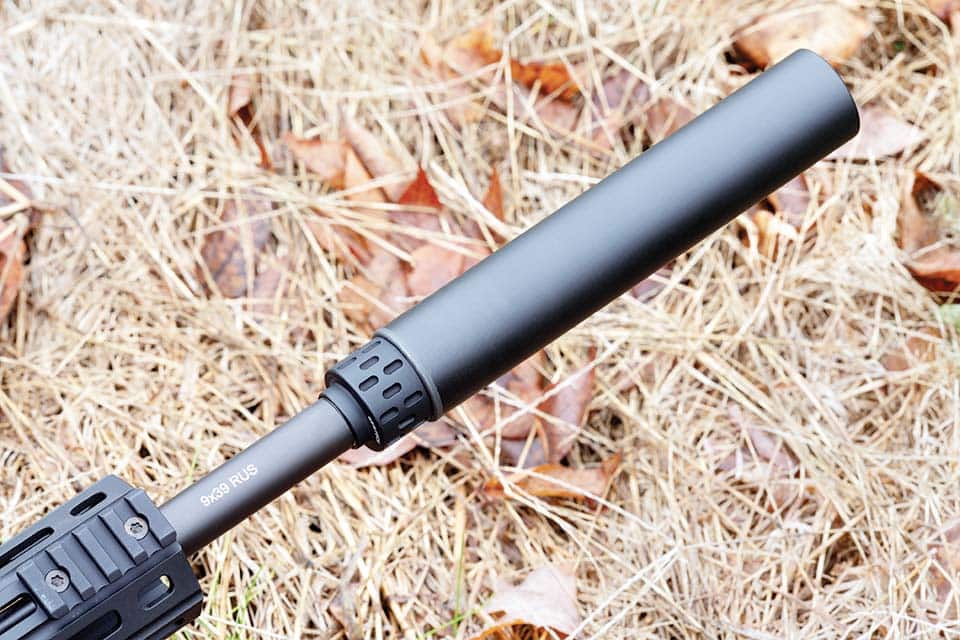
Accuracy
Unsuppressed, the rifle is accurate enough for consistent headshots past 200 yards. Suppressor compatibility was not universal. I am not sure why, as a similar .338 Spectre caliber showed no variation in accuracy with either bare muzzle or various cans. The first 9mm pistol suppressor I tried, the Gemtech Multimount, did not work well with this caliber, turning a sub-2MOA rifle into something that threw bullets fairly randomly. While the holes on paper were round and indicated no keyholing, the “group” size was around 4 feet at 60 yards! Next, I tried a Bowers Group Vers 9S, a larger tube optimized for submachine guns. Accuracy improved but only to about 8MOA. On a lark, I also tried a SilencerCo Omega 45K: despite slightly greater exit aperture and modest size, it was as quiet as the other two while delivering 3MOA groups. Once the availability of defensive ammunition increases, this cartridge will have a viable future for self-defense and short-range hunting.
| This article first appeared in Small Arms Review V24N5 (May 2020) |



